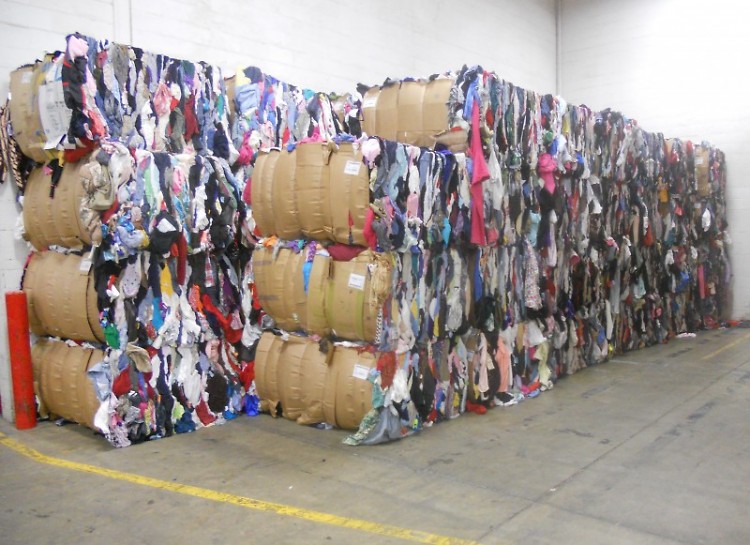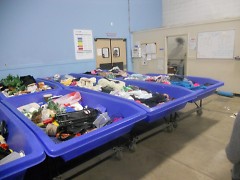In Grandville, there is a warehouse with floor-to-ceiling cardboard crates filled with stuff. Lots of stuff: unwanted holiday sweaters, broken belts and old VHS tapes. It’s the stuff that gets thrown onto the doorstep of Goodwill Industries and doesn’t find a new home with shoppers at the organization’s 15 area retail stores, two boutiques and one outlet.
So it ends up here. In the past, much of the "stuff" might have gone to a landfill. But not anymore, thanks to a heightened commitment to sustainability and the environment by Goodwill of Greater Grand Rapids. Since 2008, the organization has implemented new sustainable standards when it comes to the environment, the economy and the community.
Goodwill is working toward “finding better solutions for products,” said Nick Carlson, Goodwill’s Director of Environmental Sustainability.
Waste decreased by 60 percent from 2008 to 2010 and another 30 percent from 2010 to the present. Also in those time frames, disposal costs decreased by 68 percent and 47 percent, respectively. Behind the scenes, Goodwill finds a way to reuse or recycle nearly every item it’s given, whether it’s a broken CD or a shoe missing a mate.
In order to get the highest possible value of donated items, most are carefully assessed and go through multiple markets before winding up at the warehouse. Most articles get sold in one of the Goodwill stores, with gently used or high quality items such as antiques or books getting sold on shopgoodwill.com or other third party websites. When items don’t sell on the floor, they get sorted and sent out on trough-like bins at the Goodwill outlet store. Here, items have one hour on the floor, where they have the chance to be sold individually or by pound, depending on the product, at minimal cost. When items go unsold at the outlet, they are then categorized and sold at an even lower cost to businesses that recycle them.
Workers sort leftover clearance items into categories such as CDs, belts, pairs of shoes, single shoes, wood products and even byproducts of paper, such as the covers of old VHS tapes. This is where they are assessed on whether they are recyclable or salvageable and are then sold to a separate business for handling. The shoes are sold to developing countries for 90 cents per pound or 6 cents per pound for single shoes. Wood gets sent to a company that grinds it up, strips it of its toxic coatings and then burns it for fuel. Plastics are sent overseas to be separated and recycled.
Some questions have been raised regarding the outsourcing of Goodwill’s products, such as whether it’s safe to burn wood for fuel or send plastics across seas to be recycled, where the Goodwill name may be put at risk. Each regional Goodwill network is autonomous, working with its specific local businesses. This can make it difficult to find domestic businesses that cover all types of recycling and handling.
When there is a diverse group of recycling companies in the community there are numerous benefits because, said Carlson, “you can really serve the location specific to its needs.”
Most items are sold to local companies to be used or recycled, with the exception of plastics, which allows Goodwill to both monitor the process and contribute to the local economy.
Getting the most bang for their buck at each step of the process allows Goodwill to give back to the community by employing people under one of Goodwill’s workforce development programs that train, employ and find outside jobs for many disadvantaged individuals.
“What kind of impact do we have on our community and how many businesses do we affect by recycling?” said Carlson. “We may be a $30 million organization, but we may have a $100 million effect.”
Carlson has his eyes set on higher goals for the future. 80 percent of Goodwill’s current waste products are composite furniture, which are difficult and costly to dismantle, making them a top priority. Goodwill is also looking at countywide mattress recycling and has an energy efficiency plan that is expected to be reached by 2015.
The Rapidian, a program of the 501(c)3 nonprofit Community Media Center, relies on the community’s support to help cover the cost of training reporters and publishing content.
We need your help.
If each of our readers and content creators who values this community platform help support its creation and maintenance, The Rapidian can continue to educate and facilitate a conversation around issues for years to come.
Please support The Rapidian and make a contribution today.


